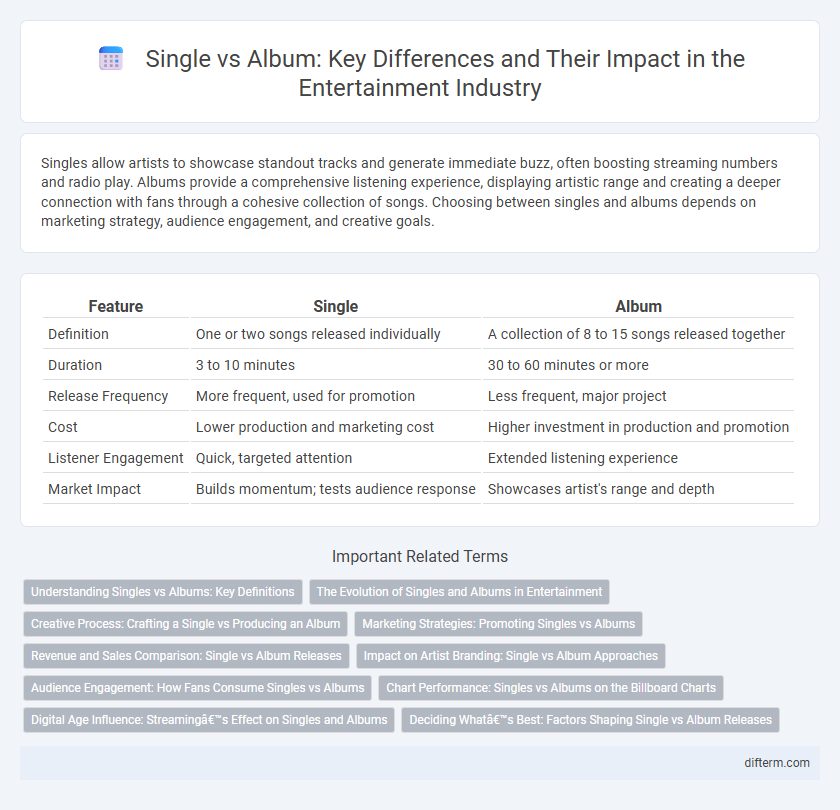Singles allow artists to showcase standout tracks and generate immediate buzz, often boosting streaming numbers and radio play. Albums provide a comprehensive listening experience, displaying artistic range and creating a deeper connection with fans through a cohesive collection of songs. Choosing between singles and albums depends on marketing strategy, audience engagement, and creative goals.
Table of Comparison
| Feature | Single | Album |
|---|---|---|
| Definition | One or two songs released individually | A collection of 8 to 15 songs released together |
| Duration | 3 to 10 minutes | 30 to 60 minutes or more |
| Release Frequency | More frequent, used for promotion | Less frequent, major project |
| Cost | Lower production and marketing cost | Higher investment in production and promotion |
| Listener Engagement | Quick, targeted attention | Extended listening experience |
| Market Impact | Builds momentum; tests audience response | Showcases artist's range and depth |
Understanding Singles vs Albums: Key Definitions
Singles are individual songs released separately to promote an artist or upcoming album, often used to gauge audience interest and maximize chart performance. Albums consist of multiple tracks bundled together, providing a comprehensive artistic statement or thematic experience, typically lasting 30-80 minutes. Understanding the difference helps in marketing strategies and consumer behavior analysis within the music industry.
The Evolution of Singles and Albums in Entertainment
The evolution of singles and albums in entertainment reflects shifts in consumer behavior and technological advancements, with singles dominating digital streaming platforms due to their instant accessibility and playlist integration. Albums continue to hold cultural significance, offering artists a cohesive narrative and deeper engagement through thematic tracks and exclusive content. The music industry's adaptation to both formats highlights a balance between immediate hits and comprehensive artistic expression.
Creative Process: Crafting a Single vs Producing an Album
Crafting a single involves intensive focus on perfecting one standout track, allowing artists to channel creativity into concise, impactful storytelling and sound design. Producing an album demands a broader creative vision, integrating multiple songs that cohesively reflect varied themes and emotions while maintaining artistic consistency. The album process often requires strategic planning of song order, transitions, and thematic development to deliver a unified listening experience.
Marketing Strategies: Promoting Singles vs Albums
Marketing strategies for singles focus on rapid audience engagement through social media campaigns, playlist placements on streaming services like Spotify, and viral music videos on platforms such as YouTube and TikTok. In contrast, album promotion involves a comprehensive approach that includes pre-release single drops, exclusive listening events, press interviews, and limited-edition merchandise to build sustained interest and fan loyalty. Data analytics on listener behavior plays a crucial role in tailoring campaign efforts for both singles and albums to maximize reach and sales.
Revenue and Sales Comparison: Single vs Album Releases
Single releases often generate faster revenue streams due to lower production costs and quicker consumption, appealing to streaming trends and consumer preferences for instant hits. Albums typically achieve higher total sales and revenue over time through bundled content, attracting dedicated fans willing to invest in a comprehensive music experience. Streaming platforms report singles outperform albums in initial monthly revenue, but albums sustain long-term profitability through deeper artist engagement and physical or deluxe edition sales.
Impact on Artist Branding: Single vs Album Approaches
Releasing singles allows artists to maintain constant visibility and adaptability, catering to fast-changing audience preferences and enhancing streaming metrics. Albums offer a cohesive narrative and deeper artistic expression, strengthening the artist's brand identity and fostering long-term fan loyalty. The strategic balance between singles and albums significantly influences brand perception and market positioning in the entertainment industry.
Audience Engagement: How Fans Consume Singles vs Albums
Singles capture immediate attention and drive high streaming numbers through focused, repeatable consumption, enhancing short-term audience engagement. Albums encourage deeper exploration, fostering emotional connection and sustained interaction as fans experience the curated narrative and diverse tracks. Streaming platforms' playlist algorithms amplify singles' reach, while albums build loyalty through comprehensive storytelling and fan investment.
Chart Performance: Singles vs Albums on the Billboard Charts
Singles often achieve higher peak positions and faster entry on the Billboard Hot 100 compared to albums on the Billboard 200, driven by streaming and digital sales. Albums generally sustain longer chart longevity due to cumulative track performance and fanbase support, impacting Billboard 200 rankings over time. The dynamic between streaming equivalents and traditional sales continues to shape the distinct chart trajectories for singles versus full albums.
Digital Age Influence: Streaming’s Effect on Singles and Albums
Streaming platforms have revolutionized music consumption by prioritizing singles over full albums, leading to a surge in standalone track releases. Algorithms favor frequent single drops to maintain artist visibility and boost playlist placements, often sidelining traditional album formats. This shift impacts revenue models and artist strategies, accelerating the trend toward bite-sized, instantly accessible music experiences.
Deciding What’s Best: Factors Shaping Single vs Album Releases
Artists weigh factors such as audience engagement, streaming metrics, and marketing strategies when deciding between releasing singles or full albums. Singles often capitalize on immediacy and viral potential, while albums offer a cohesive artistic narrative and deeper fan connection. Revenue models and promotional cycles also influence this choice, balancing short-term attention with long-term brand building.
single vs album Infographic

 difterm.com
difterm.com